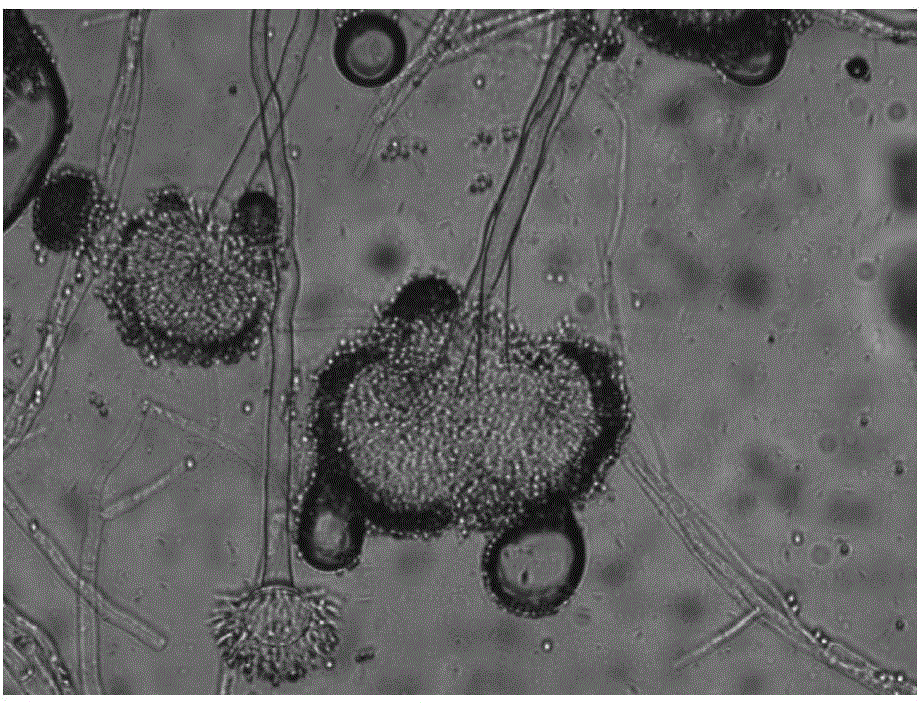Dragonfly intestinal bacterium aspergillus terreus QT122 and metabolite and application thereof
A technology of QT122 and metabolites, which is applied to the intestinal symbiotic Aspergillus terreus strain and its metabolites and application fields, can solve the problems of chemical herbicide environmental pollution, pesticide residue weed resistance, etc., and achieve the effect of good herbicidal activity
- Summary
- Abstract
- Description
- Claims
- Application Information
AI Technical Summary
Problems solved by technology
Method used
Image
Examples
Embodiment 1
[0031] Example 1. Isolation, purification and identification of dragonfly intestinal symbiotic Aspergillus terreus (Aspergillus terreus QT122):
[0032] The tested dragonflies were collected from the suburbs near Zhejiang Normal University. The captured dragonflies were starved for 24 hours, disinfected with 75% (volume %) alcohol for 2 minutes under aseptic conditions, rinsed with sterile water for 3 times, and dissected with sterile tweezers. Take out the intestinal tract and put it in a sterile mortar, add a small amount of sterile water for grinding, and then dilute it to 10% with sterile water -1 、10 -2 、10 -3 three concentration gradients. Take 0.2 mL of each concentration gradient dilution solution and spread it on the malt solid medium (MEA medium), and culture it upside down in a 28°C incubator. After the colony grows, pick a small amount of hyphae from the edge of the colony and transfer it to a new MEA medium. Repeat this transfer to obtain a single colony, and ...
Embodiment 2
[0038] Embodiment 2, the liquid fermentation of dragonfly intestinal symbiotic Aspergillus terreus (Aspergillus terreus QT122):
[0039] Activation of Aspergillus terreus (Aspergillus terreus QT122): Take the mycelium block (about 1-2g) with bacteria from the slope of the MEA test tube of the preserved strain, put it on the fresh malt solid medium (MEA), and put it in a 28°C incubator Inverted culture, the activated Aspergillus terreus (Aspergillus terreus QT122) was obtained.
[0040] Inoculate the mycelium block (about 2 to 3 g) of the activated Aspergillus terreus QT122 into a 250 mL Erlenmeyer flask containing 150 mL of malt liquid medium (ME medium), at 28 ° C, 170 rpm / min Cultivate under conditions for 3 days as seed solution; inoculate 6-7 bottles in total.
[0041] Then, according to the inoculation amount of 1% volume ratio, 5 ml of the seed solution was transferred into a 1000 mL Erlenmeyer flask equipped with 500 mL of malt liquid medium (ME medium), and cultivated...
Embodiment 3
[0043] Example 3. Separation and purification of metabolites from dragonfly intestinal symbiotic Aspergillus terreus QT122:
[0044] The 40L fermented liquid prepared according to the method described in Example 2 was filtered through 4 layers of gauze, and the obtained filtrate was extracted with an equal volume of ethyl acetate for a total of 3 times, and the extract was concentrated and dried in a vacuum (in 0.1 negative Pressed vacuum degree, 45 ℃ drying 30~40 minutes), obtain brown fermented broth crude extract (26.23g).
[0045] The obtained fermented broth crude extract (26.23g) was crudely separated by silica gel column chromatography (200-300 mesh silica gel, about 260g), and gradient elution was carried out using dichloromethane / methanol. The volume ratios are: 100:0, 100:1, 100:2, 100:4, 100:8, 100:16, 100:32; the amount of each eluent is about 5100ml, 4500ml, 3750ml, 3000ml, 2250ml, 1500ml, 1500ml, and the flow rate is 10ml / min . Different gradient elutions were ...
PUM
 Login to View More
Login to View More Abstract
Description
Claims
Application Information
 Login to View More
Login to View More - R&D Engineer
- R&D Manager
- IP Professional
- Industry Leading Data Capabilities
- Powerful AI technology
- Patent DNA Extraction
Browse by: Latest US Patents, China's latest patents, Technical Efficacy Thesaurus, Application Domain, Technology Topic, Popular Technical Reports.
© 2024 PatSnap. All rights reserved.Legal|Privacy policy|Modern Slavery Act Transparency Statement|Sitemap|About US| Contact US: help@patsnap.com










